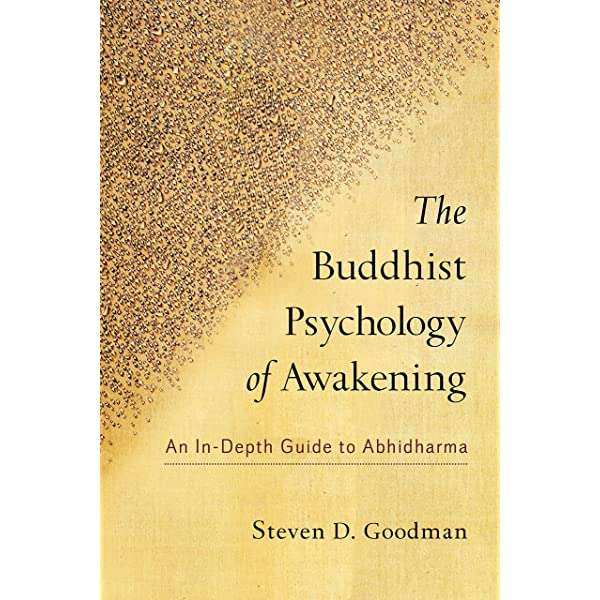Steven D. Goodman
Praise
“The Buddhist Psychology of Awakening shines new light on the profound fundamentals of Buddhism with original insight, vibrant reasoning, and pristine clarity. It is a great gift of scholarly exposition and a cause for celebration.” —Tulku Thondup Rinpoche, author of Masters of Meditation and Miracles
“I’ve been waiting for the book that would detail the Tibetan branch of Buddhist psychology with authority and clarity. At last, here it is. Steven Goodman’s book is witty, wise, and a pleasure to read.” —Daniel Goleman, author of Emotional Intelligence
“Abhidharma holds the heart of early Buddhist wisdom. Goodman’s gift is to bring this forward in friendly, everyday language that never loses touch with the original sources. As he says, the eightfold path is a journey into our own experience, a fresh way to see life and diminish its pain, and this is relevant to everyone.” —Anne C. Klein (Rigzin Drolma), author of Heart Essence of the Vast Expanse
Selected Reader Reviews
About
The Buddhist Psychology of Awakening
A modern introduction to traditional Buddhist psychology
This practical overview of Buddhist psychology outlines step-by-step methods for examining the source of our habitual tendencies and hangups. In order to truly free ourselves from perpetuating patterns of suffering, the Buddha offered a clear system for understanding our psychological dispositions, processes, fixations, and challenges–a system known as the Abhidharma. This tradition has been studied by Buddhists for over two millennia.
Professor Steven Goodman has taught on the Abhidharma in both universities and Buddhist retreats for over twenty years, making these traditional teachings accessible for a modern readership for the first time. Goodman explains how becoming aware of our mental patterns can liberate us from cycles of emotional pain and shows how the Abhidharma can be applied to meditation practice through exercises of observation and reflection. This is the go-to manual for anyone interested in the world of Buddhist psychology.
[DISCLOSURE: I was a direct student of the author for several years up until his death, and received a free review copy of this work with no strings attached.]
This is the most clear and readable, if not the most in-depth, introduction to abhidharma—which according to some, including the author and one of his professors, “should be the bedrock and starting point for all Buddhist studies”—I have encountered in my 30 years of exposure to Buddhism. Many students of the buddhadharma find the abhidhar
This is the most clear and readable, if not the most in-depth, introduction to abhidharma—which according to some, including the author and one of his professors, “should be the bedrock and starting point for all Buddhist studies”—I have encountered in my 30 years of exposure to Buddhism. Many students of the buddhadharma find the abhidharma (literally “higher dharma”) teachings to be particularly difficult, in that they are “for the most part, rather technical, consisting of main points and enumerated lists of basic factors (dharmas) of phenomena mentioned in the sutras.” This, plus the archaic language and lingustic barriers, can make the work of its principle expositor, the 4th-century monk
Highly recommended for anyone whose interest in Buddhism almost, but not quite, evaporated upon first encountering the 75 Dharmas and 51 Mental Factors, and those who desire to deepen their relationship with their own minds on and off the meditation cushion.
[DISCLOSURE: I was a direct student of the author for several years up until his death, and received a free review copy of this work with no strings attached.]This is the most clear and readable, if not the most in-depth, introduction to abhidharma—which according to some, including the author and one of his professors, “should be the bedrock and starting point for all Buddhist studies”—I have encountered in my 30 years of exposure to Buddhism. Many students of the buddhadharma find the abhidharma (literally “higher dharma”) teachings to be particularly difficult, in that they are “for the most part, rather technical, consisting of main points and enumerated lists of basic factors () of phenomena mentioned in the sutras.” This, plus the archaic language and lingustic barriers, can make the work of its principle expositor, the 4th-century monk Vasubandhu , all but impenetrable to those Westerners who are not utterly committed to absorbing it. Dr. Goodman does an excellent job of minimizing the jargon, explicating it where it is necessary to retain the terminology for precision, and making this ancient material relevant to modern-day experience, with more than a dollop of his characteristic good humor. Additionally, his phenomenological approach, likely attributable to his fondness for Husserl and his prior work with Günther , bring many of the seemingly abstract categories well into the realm of relatable experience.Highly recommended for anyone whose interest in Buddhism almost, but not quite, evaporated upon first encountering the 75 Dharmas and 51 Mental Factors, and those who desire to deepen their relationship with their own minds on and off the meditation cushion.
This practical overview of Buddhist psychology outlines step-by-step methods for examining the source of our habitual tendencies and hangups. In order to truly free ourselves from perpetuating patterns of suffering, the Buddha offered a clear system for understanding our psychological dispositions, processes, fixations, and challenges–a system known as the Abhidharma. This tradition has been studied by Buddhists for over two millennia.
Professor Steven Goodman has taught on the Abhidharma in both universities and Buddhist retreats for over twenty years, making these traditional teachings accessible for a modern readership for the first time. Goodman explains how becoming aware of our mental patterns can liberate us from cycles of emotional pain and shows how the Abhidharma can be applied to meditation practice through exercises of observation and reflection. This is the go-to manual for anyone interested in the world of Buddhist psychology.
The Buddhist Psychology of Awakening: An In-Depth Guide to the Abhidharma, by Steven D. Goodman, is an introduction to the Abhidharma and Buddhist psychology intended for Western readers. The text is based on the Indo-Tibetan textual tradition of the Abhidharma.
From the Publisher:
Professor Steven D. Goodman, who has honed his presentation of this system of psychology to a generation of students, presents the first practical, relatable, and direct overview of the Abhidharma. This guide outlines step-by-step methods for examining the source of our habitual tendencies and hang-ups, showing how we can liberate ourselves from cycles of emotional pain by becoming aware of our mental patterns on the subtlest levels. Goodman explains how the Abhidharma can be applied to meditation practice through exercises of observation and reflection, making this the go-to manual for anyone interested in understanding how the mind really works.[1]
Origin of the text
From the author:
Many years ago, at the newly established Nyingma Institute in Berkeley, California, the head Tibetan Buddhist teacher Tarthang Tulku urged me to begin an intensive study of what was then available of the Abhidharma literature in European languages. To that end, I prepared a rough translation from the French of the “Abdhidharma” section of Etienne Lamotte’s L’Histoire du Buddhisme Indien, which is now available in English translation. Then I delved into a study of Louis de la Vallée-Poussin’s French translation of Vasubandhu’s Kosha, entitled L’Abhidharmakosha, now also available in English translation by Pruden (1991). This background work was soon supplemented by a study of the Tibetan translations of Vasubandhu’s work, works written in Tibetan as commentaries on the Kosha, and works written by Indian commentators. Finally, I was led to study and translate key portions of Ju Mipham Rinpoche’s Gateway to Knowledge and the commentary on it by Kathog Khenpo Nuden. This text by Mipham is now also available in English in full, translated by Erik Pema Kunsang.What I culled from these studies was a desire to present “key points of view” to eager graduate students at the Graduate Theological Union in Berkeley, via its affiliation with the newly established Nyingma Institute. These students were bright and engaged and asked many questions about the diverse categories of dharmas and their arrangement into “conditioned” and “unconditioned.” They also asked what any of this had to do with the foundational teachings of the Buddhadharma, such as the four noble truths (suffering, the causes of suffering, the cessation of suffering, and the path leading to the cessation of suffering). From the very beginnings of teaching this material, we explored the possible implications for what emerged as what we might call a special kind of “Buddhist psychology” and how such study might inspire and provoke a new way forward into foundational and transformational practices.Sometime after those initial presentations, I was invited to explore these approaches at the Naropa Institute (now Naropa University) in Boulder, Colorado, to a lively and engaged group of Buddhist students. In subsequent years, and through many refinements, this material was taught in courses at the California Institute of Integral Studies in San Francisco and at a summer study program at the Rigpa Shedra in Southern France.Thus, what you have before you is a reworked and edited presentation of these lectures and teaching materials that are based on the Indo-Tibetan textual traditions of Abhidharma.
Articles
- “Why Should I Care about the Abhidharma?”, Lion’s Roar, Aug 2020 (adapted from The Buddhist Psychology of Awakening)
References
Sources




